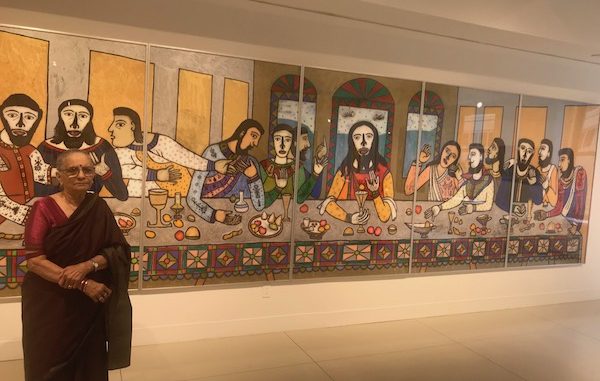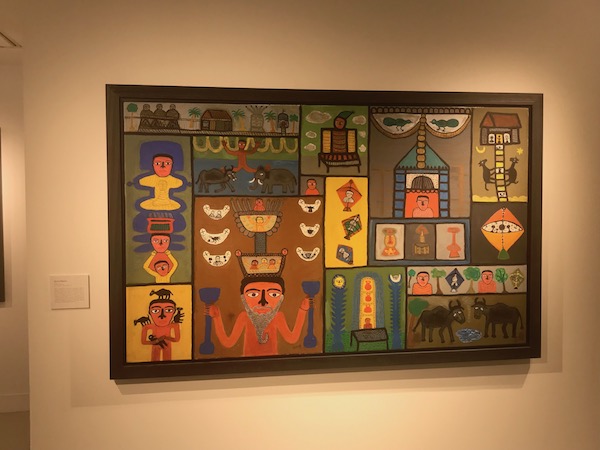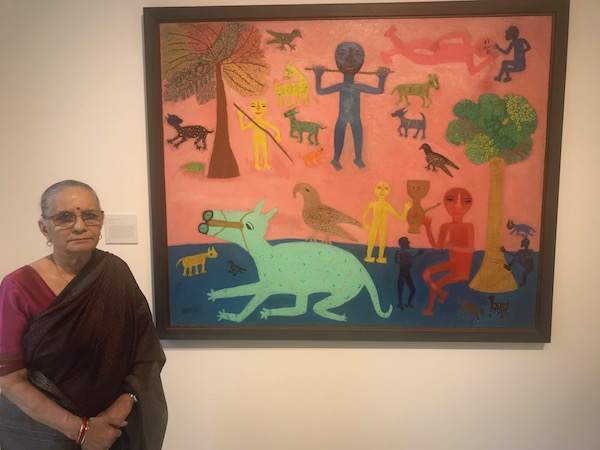
Ashok Ojha
NEW YORK CITY(TIP): When I met Madhvi Parekh at the Delhi Art Gallery in Midtown Manhattan I saw a simple lady loaded with varied experiences of life. Born in a small village in Gujarat Madhvi had a lot to share from five decades of her life. She sat in a couch, looked at her paintings, more than 65 of them, hanging on the walls of the gallery, aptly titled, ‘The Curious Seeker’.
The Curious Seeker offers an unparalleled opportunity to explore Madhvi’s evolution as an artist, from her roots in folk tradition, to the myriad ways that she diverged from conventions to create her own distinctive style. Madhvi’s paintings displays simple stories about children playing under the shadows of trees, dogs and animals roaming around, birds flying in the sky and girls happily decorating houses. These images remind us of simple rural color work done mostly by girls and women for the purpose of decorating houses, courtyards and entrances, called Rangoli. Madhvi captured such images on canvas relating directly to the visuals so common in Indian villages.
 Madhvi was deeply influenced by the Amul Dairy network and its relationship with milk producers of Gujarat. “The never-ending network of milk production amazed me, said Madhvi, “It left a deep mark in my imagination that I carried all my life.”
Madhvi was deeply influenced by the Amul Dairy network and its relationship with milk producers of Gujarat. “The never-ending network of milk production amazed me, said Madhvi, “It left a deep mark in my imagination that I carried all my life.”
She featured varieties of images in her art. These images change forms and shapes. They come together to represent joyous universes of living beings. ‘Playing with Animals’ explores her happy childhood spent in the fields of her village as part of the rhythm of life, encompassing nature and seasons, birds and beasts, and her friends. Apart from folk motifs, legends, and figures, Madhvi also uses imaginary characters in figurative and abstracted orientations in her compositions, demonstrating her use of rhythm and repetition. She utilizes the familiar settings and motifs of Kalamkari, a traditional hand-painted or block-printed cotton textile, and Pichwai, devotional pictures on cloth or paper, in which she enshrines the main character of the composition in the center and fills the minor or secondary ones in the borders.
 The simplicity of her art, deeply rooted in rural India, has an international persona. She recreated Leonardo da Vinci’s ‘Last Supper’, a masterpiece that touched the Christian genres of art with visual strategies from a range of different eras and religious cultures.
The simplicity of her art, deeply rooted in rural India, has an international persona. She recreated Leonardo da Vinci’s ‘Last Supper’, a masterpiece that touched the Christian genres of art with visual strategies from a range of different eras and religious cultures.

 Her work has been featured in exhibitions around the world; San Jose, Tokyo, Seoul,Hambur, Kolkata and New Delhi. She is engaged in promoting art and young artists along with her husband, the renowned artist Manu Parekh. Thought she had had no formal education in art, her work evolved from folk stories and childhood memories.
Her work has been featured in exhibitions around the world; San Jose, Tokyo, Seoul,Hambur, Kolkata and New Delhi. She is engaged in promoting art and young artists along with her husband, the renowned artist Manu Parekh. Thought she had had no formal education in art, her work evolved from folk stories and childhood memories.




Be the first to comment